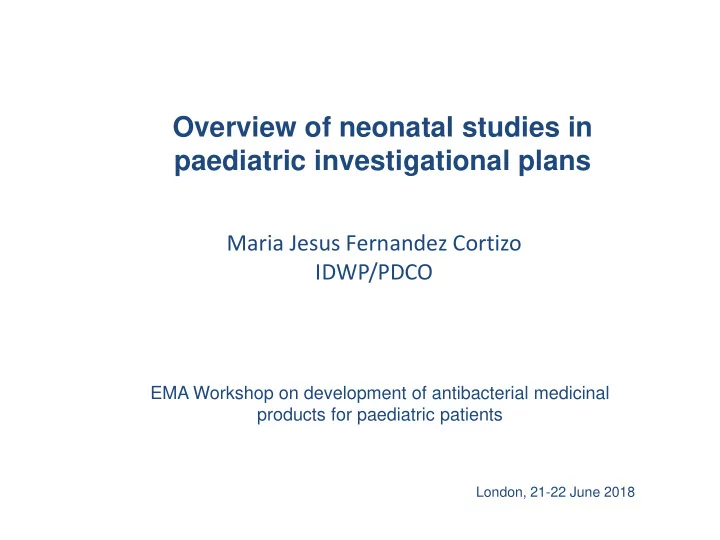

Overview of neonatal studies in paediatric investigational plans Maria Jesus Fernandez Cortizo IDWP/PDCO EMA Workshop on development of antibacterial medicinal products for paediatric patients London, 21-22 June 2018
Reminder • The ultimate goal of the paediatric plan is to allow granting an indication and a posology in the relevant subsets of the paediatric population where there is significant therapeutic benefit or an unmet need • The only opportunity to request studies in neonates is during the initial assessment of the PIP; requesting a neonatal study later on (PIP modifications) will not be possible • The neonatal study needs to be reflected in the PIP opinion, i.e., a study synopsis should be included with a number of binding elements • Off-label use of drugs remains very high in neonates (87.7% of neonates in an Italian multicenter study of 107 Italian level III neonatal intensive care units received at least one off-label/unlicensed prescription, with anti- infectives being the most common medicines used). *Cuzzolin L, Agostino R. Eur J Clin Pharmacol. 2016;72(1):117-23.
Neonatal period • ICH E11(R1) guideline on clinical investigation of medicinal products in the pediatric population (step 5) • Neonate: up to 44 completed weeks post-menstrual age (gestational age and postnatal age) • Neonatal period: • term and post-term newborn infants is defined as the day of birth plus 27 days. • preterm newborn infants is defined as the day of birth through the expected date of delivery plus 27 days.
Paediatric addendum (neonates) Pharmacokinetic data will need to be generated in neonates in almost all cases owing to the rapid developmental changes in absorption, distribution, metabolism and excretion. In term and preterm neonates it may be difficult or impossible to determine the primary site of infection. In this population, it may be necessary to obtain pharmacokinetic data for the test antibacterial agent in patients with suspected or proven late-onset sepsis with no known primary focus who are receiving standard of care antibacterial regimens.
Overview PIPs including neonatal studies • 30 agreed PIPs (with EMA decision)/26 different active substances – excluding antibacterial agents for inhalation (e.g. cystic fibrosis) and for eradication of H pylori • 17 include neonatal studies. Just two completed the neonatal study. • Clinical development in neonates: – 2 studies • Single dose PK study including all age groups PLUS • PK and safety study after repeated doses usually confined to children below 2 or 3 months of age OR – Single PK and safety study assessing both single and multiple doses usually confined to children below 2 or 3 months of age • No waiver except for safety reasons (e.g., tetracyclines for site- specific indications for which there are alternative options available) • Most neonatal studies are deferred
Overview neonatal studies in agreed PIPs • Single dose PK assessment always done • Repeated doses usually requested for safety reasons (but this may be needed also for, e.g., non-linear kinetics) • Three randomised, active-comparator efficacy and safety studies • Study population: – Late-onset sepsis (LOS) (n=8) – Bacterial meningitis (n=1) – Gram-negative bacterial infections (n=2) – Clostridium difficile infection (no specific numbers quoted, i.e., acknowledging the high rate of colonisation) (n=3) • Sample size (PK and safety study) ranges from 10 to 60 (most of them ≥ 20) • Children who are scheduled for lumbar puncture, measurement of drug in CSF
Topics repeatedly discussed • PK studies: - justification sample size - appropriate distribution (number) according to factors affecting pharmacokinetics of the drug (e.g. GA and PNA in drugs eliminated via the kidney) - neonates preferably studied separately from other age cohorts - sparse or semirich sampling and justification for sampling schedule - blood volume per sample/microsampling assays • Condition for neonatal studies - suspected or proven late-onset sepsis - are other conditions realistic (e.g., Gram-negative bacterial infections, cUTI) • Characteristics of PK studies – add-on therapy (not an issue in single dose PK studies) • Staggered approach – delays availability of new drug to neonates – in well tolerated agents may not be justified
Why late-onset sepsis? • The classical adult clinical syndrome-based (licensing) studies do not apply to neonates, where sepsis is the most common infection. Why not? • Due to the systemic nature of the infection there is a risk of Central Nervous System (CNS) infection that may be difficult to rule out • It should be known whether the antibiotic distributes significantly to the CNS which for new agents is usually not the case Of note, an indication in neonatal sepsis will not be granted based on these studies (for that purpose randomised, controlled studies powered for efficacy should be conducted)
Why add-on/combination therapy • Need to cover meningitis given the immaturity of the immunological system, particularly in preterm neonates • Not always needed (e.g., combination of a known beta-lactam with a beta-lactamase inhibitor if the former is authorised for meningitis) Why is it difficult? • Rationale use of antibiotics may prohibit the use of add- on/combination therapy (depending on the antibacterial agent) • Restrictions to the number of doses that can be administered (based on, e.g., clinical practice) • If the purpose (of multiple doses) is safety, interpretation of (combination/add-on) data in a limited number of neonatal patients may be difficult
Conclusions • (Late-onset) neonatal sepsis selected because is the most common infection in neonates but an indication in neonatal sepsis will not be granted based on the studies requested • Trials involving neonates are difficult to perform but single dose PK studies are feasible • Unclear that single dose PK studies suffice to reasonably conclude on safety→multiple dose studies usually requested which considerably complicates study design • The number of neonates that can be reasonably studied is limited • Role of pharmacovigilance in the post-marketing phase is fundamental
Recommend
More recommend